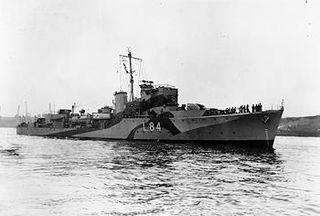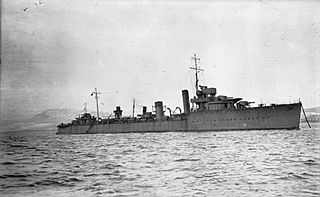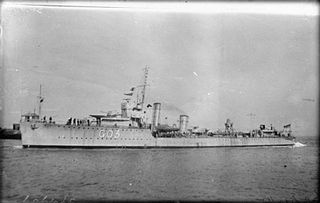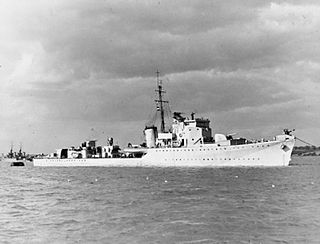
The first USS Twiggs (DD–127) was a Wickes-class destroyer in the United States Navy during World War I. She was named for Major Levi Twiggs. She was later transferred to the Royal Navy, as HMS Leamington and to the Soviet Navy as Zhguchy, before returning to Britain to star in the film The Gift Horse, which depicts the St. Nazaire Raid.

HMS Campbeltown was a Town-class destroyer of the Royal Navy during the Second World War. She was originally US destroyer USS Buchanan, and was one of 50 obsolescent U.S. Navy destroyers transferred to the Royal Navy in 1940 as part of the Destroyers for Bases Agreement. Campbeltown became one of the most famous of these ships when she was used in the St Nazaire Raid in 1942.

HMS Legion was an L-class destroyer of the Royal Navy. She entered service during the Second World War, and had a short but eventful career, serving in Home waters and the Mediterranean. She was sunk in an air attack on Malta in 1942. The ship had been adopted by the British civil community of the Municipal Borough of Cheltenham, Gloucestershire in November 1941.

HMS Hursley was a Second World War Type II Hunt-class escort destroyer of the British Royal Navy. She is the only Royal Navy ship to have carried this name. Hursley is a village in Hampshire. Commissioned in 1942, she served in the Mediterranean, before being transferred to the Hellenic Navy in November 1943 and renamed Kriti. She took part in the landings in Sicily, Anzio, and southern France, and remained in Greek service until 1959.

The Mediterranean U-boat Campaign lasted from about 21 September 1941 to 19 September 1944 during the Second World War. Malta was an active British base strategically located near supply routes from Europe to North Africa. Axis supply convoys across the Mediterranean Sea suffered severe losses, which in turn threatened the fighting ability of the Axis armies in North Africa. The Allies were able to keep their North African armies supplied. The Kriegsmarine tried to isolate Malta but later it concentrated its U-boat operations on disrupting Allied landing operations in southern Europe.

HMS Warwick (D25) was an Admiralty W-class destroyer built in 1917. She saw service in both the First and Second World Wars, before being torpedoed and sunk in February 1944.

HMS Opportune was an O-class destroyer of the Royal Navy. She was ordered from John I. Thornycroft & Company, Woolston on 3 September 1939 for the 1st Emergency Flotilla. She was commissioned on 14 August 1942. She was the second Royal Navy ship borne Opportune.

HMS Vortigern was a V-class destroyer of the Royal Navy. She served in both World Wars, and was sunk in 1942.

HMS Wrestler (D35) was a V and W-class destroyer built by the Royal Navy during the First World War and active from 1939 to 1944 during the Second World War. She was the first Royal Navy ship to bear that name, and the only one to do so to date.

HMS Holcombe was a Type III Hunt-class destroyer of the Royal Navy. She was named after the Holcombe Hunt in Lancashire. She was the first and thus far only ship of the Royal Navy named HMS Holcombe.
German submarine U-593 was a Type VIIC U-boat built for Nazi Germany's Kriegsmarine for service during World War II. She was laid down on 17 December 1940 by Blohm & Voss in Hamburg as yard number 569, launched on 3 September 1941 and commissioned on 23 October under Kapitänleutnant Gerd Kelbling.

HMS Calpe was a British Royal Navy Type II Hunt-class destroyer escort. Built as a result of the outbreak of World War II, Calpe escorted convoys during the war and participated in the Dieppe Raid. Calpe is an old name for Gibraltar. Collaborating with USS Wainwright on 13 December 1943, she assisted in the sinking of German U-boat U-593. Calpe was loaned and then sold to the Danish Navy, remaining active until she was scrapped in Sweden in 1966.

HMS Ekins (K552) was a British Captain-class frigate of the Royal Navy that served during World War II. Originally constructed as a United States Navy Buckley class destroyer escort, she served in the Royal Navy from 1943 to 1945.

The second HMS Hambledon was a Hunt-class destroyer of the Royal Navy in commission from 1940 to 1945. She was a member of the first subgroup of the class, and saw service throughout World War II.

The second HMS Wivern, was a Modified W-class destroyer of the British Royal Navy that saw service in World War II.

HMS Albrighton was a Type III Hunt-class destroyer built for the British Royal Navy. She entered service in February 1942, first carrying out an attack on German ships in the English Channel then taking part in the Dieppe Raid, rescuing survivors from the sinking destroyer HMS Broke. Albrighton was next assigned to search for and destroy the German auxiliary cruiser Komet, then escorted a convoy to Gibraltar in prevision of the Allied landings in North Africa. Between December 1942 and April 1943, she participated in the sinking of three more Axis ships with the First Destroyer Flotilla. During the Normandy Landings in June 1944, Albrighton served as a headquarters ship, then sank two German trawlers in the weeks after the invasion. After being converted to a destroyer in early 1945, she was damaged in a collision with a Landing Ship, then was assigned to the British Eastern Fleet. However, the war ended before she was deployed and Albrighton went into reserve.

HMS Atherstone was a Hunt-class destroyer of the Royal Navy. She was launched in late 1939 as the first of her class but was found to be unstable, and had to undergo significant modifications before entering service in March 1940.

HMS Pakenham (G06) was a P-class destroyer of the British Royal Navy built and operated during World War II. Commissioned in early 1942, she took part in the invasion of Madagascar, and several Malta Convoys, before being disabled in a battle with Italian torpedo boats in April 1943 and scuttled.

HMS Douglas was an Admiralty type flotilla leader of the British Royal Navy. Built by Cammell Laird, Douglas commissioned in 1918, just before the end of the First World War. During the Second World War, Douglas served with Force H out of Gibraltar and as a convoy escort. She was sold for scrap in March 1945.

HMS Brocklesby was a Type I Hunt-class destroyer of the Royal Navy. She served during the Second World War, spending much of the time in the English Channel and Mediterranean, taking part in the Dieppe Raid in 1942, and the Allied landings in Sicily and at Salerno in 1943. After the war, she was used as a sonar trials ship until 1963, and was sold for scrap in 1968.



















